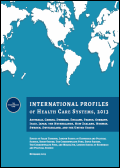SELECTED FOR YOU... DECEMBER 2013:
 books of the month
books of the month
 watch on health economics
watch on health economics
All the Selected for you
BOOKS
Health at a Glance 2013. OECD indicators.
Organisation de Coopération et de Développement Economiques. (OCDE). Paris. FRA
Paris : OCDE, 2013
This seventh edition of Health at a Glance provides the latest comparable data on different aspects of the performance of health systems in OECD countries. It provides striking evidence of large variations across countries in the costs, activities and results of health systems. Key indicators provide information on health status, the determinants of health, health care activities and health expenditure and financing in OECD countries. Each indicator in the book is presented in a user-friendly format, consisting of charts illustrating variations across countries and over time, brief descriptive analyses highlighting the major findings conveyed by the data, and a methodological box on the definition of the indicator and any limitations in data comparability. This publication takes as its main basis OECD Health Statistics 2013, the most comprehensive set of statistics and indicators for comparing health systems across the 34 OECD member countries.
Hospitals and borders. Seven case studies on cross-border collaboration and health system interactions.
Organisation Mondiale de la Santé. (OMS). Genève. CHE,European Observatory on Health Systems and Policies. Brussels. BEL,Observatoire Européen des Systèmes et des Politiques de Santé. Bruxelles. BEL
Copenhague : OMS Bureau régional de l'Europe, 2013
The European Union (EU) Directive on the application of patients' rights in cross-border health care explicitly calls for Member States to cooperate in crossborder health care provision in border regions. Given that most crossborder collaboration in the health care field involves secondary care, the legal text places hospitals close to national frontiers at the centre of attention. But how do hospitals interact with each other and with other health care actors across borders? Why does cross-border collaboration take place? Who actually benefits from it? And when does it work? These are the questions at the heart of the present volume. Seven case studies examine the circumstances under which cross-border collaboration is likely to work; the motivations and incentives of health care actors;and the role played by health systems, individuals and the EU in shaping crossborder collaboration. The study is original in that it produces qualitative and analytical scientific evidence on aspects of cross-border collaboration involving hospitals from a geographically diverse selection of cases covering 11 EU and non-EU countries (Austria, Belgium, Bulgaria, Denmark, Finland, France, Germany, the Netherlands, Norway, Romania, and Spain). This book is of interest to decision-makers and field actors engaged in or considering cross-border collaboration. Questions on feasibility, desirability and implementation are at the core of the analysis. The book puts forward policy conclusions directly linked to the EU Directive on patients' rights and proposes a “toolbox” of prerequisites necessary to start or maintain cross-border collaboration in health care. In addition to its deliberate policy perspective, it is relevant to observers and students of the intersection between the EU and domestic health systems known as cross-border health care.
Health system review : Austria.
Hofmarcher M.M.
Observatoire Européen des Systèmes et des Politiques de Santé. Bruxelles. EUR,European Observatory on Health Systems and Policies. Brussels. EUR
Copenhague : OMS Bureau régional de l'Europe, 2013
The Health Systems in Transition (HiT) series provide detailed descriptions of health systems in the countries of the WHO European Region as well as some additional OECD countries. An individual health system review (HiT) examines the specific approach to the organization, financing and delivery of health services in a particular country and the role of the main actors in the health system. It describes the institutional framework, process, content, and implementation of health and health care policies. HiTs also look at reforms in progress or under development and make an assessment of the health system based on stated objectives and outcomes with respect to various dimensions (health status, equity, quality, efficiency, accountability). This new Hit for Austria reports that Austrians are much more satisfied with their health system than most of their fellow Europeans. This could be explained by the high level of coverage and provider choice that Austrian patients generally enjoy and by the decentralized planning and governance of the system that allows to cater for local needs and preferences. However these same factors are also likely to generate fragmentation and lack of coordination, which makes the Austrian health system more costly than average and could hamper its performance. This is why since 2005, with the creation of the Federal Health Agency and regional health platforms, reform is aimed at intensifying cross-stakeholder coordination at all levels and promoting outpatient care.
Multilevel modeling techniques and applications in institutional research.
San Francisco : John Wiley & Sons , 2012
Multilevel modeling is an increasingly popular multivariate technique that is widely applied in the social sciences. Increasingly, practitioners are making instructional decisions based on results from their multivariate analyses, which often come from nested data that lend themselves to multilevel modeling techniques. As data-driven decision making becomes more critical to colleges and universities, multilevel modeling is a tool that will lead to more efficient estimates and enhance understanding of complex relationships. This volume illustrates both the theoretical underpinnings and practical applications of multilevel modeling in IR. It introduces the fundamental concepts of multilevel modeling techniques in a conceptual and technical manner. Providing a range of examples of nested models that are based on linear and categorical outcomes, it then offers important suggestions about presenting results of multilevel models through charts and graphs (4e de couverture).
International Profiles of Health Care Systems, 2013.
Thomson S., Osborn R., Squires D.
Commonwealth Fund. New York NY. USA
New York : The Commonwealth Fund, 2013/11
This publication presents overviews of the health care systems of Australia, Canada, Denmark, England, France, Germany, Japan, Italy, the Netherlands, New Zealand, Norway, Sweden, Switzerland, and the United States. Each overview covers health insurance, public and private financing, health system organization and governance, health care quality and coordination, disparities, efficiency and integration, use of information technology and evidencebased practice, cost containment, and recent reforms and innovations. In addition, summary tables provide data on a number of key health system characteristics and performance indicators, including overall health care spending, hospital spending and utilization, health care access, patient safety, care coordination, chronic care management, disease prevention, capacity for quality improvement, and public views.





